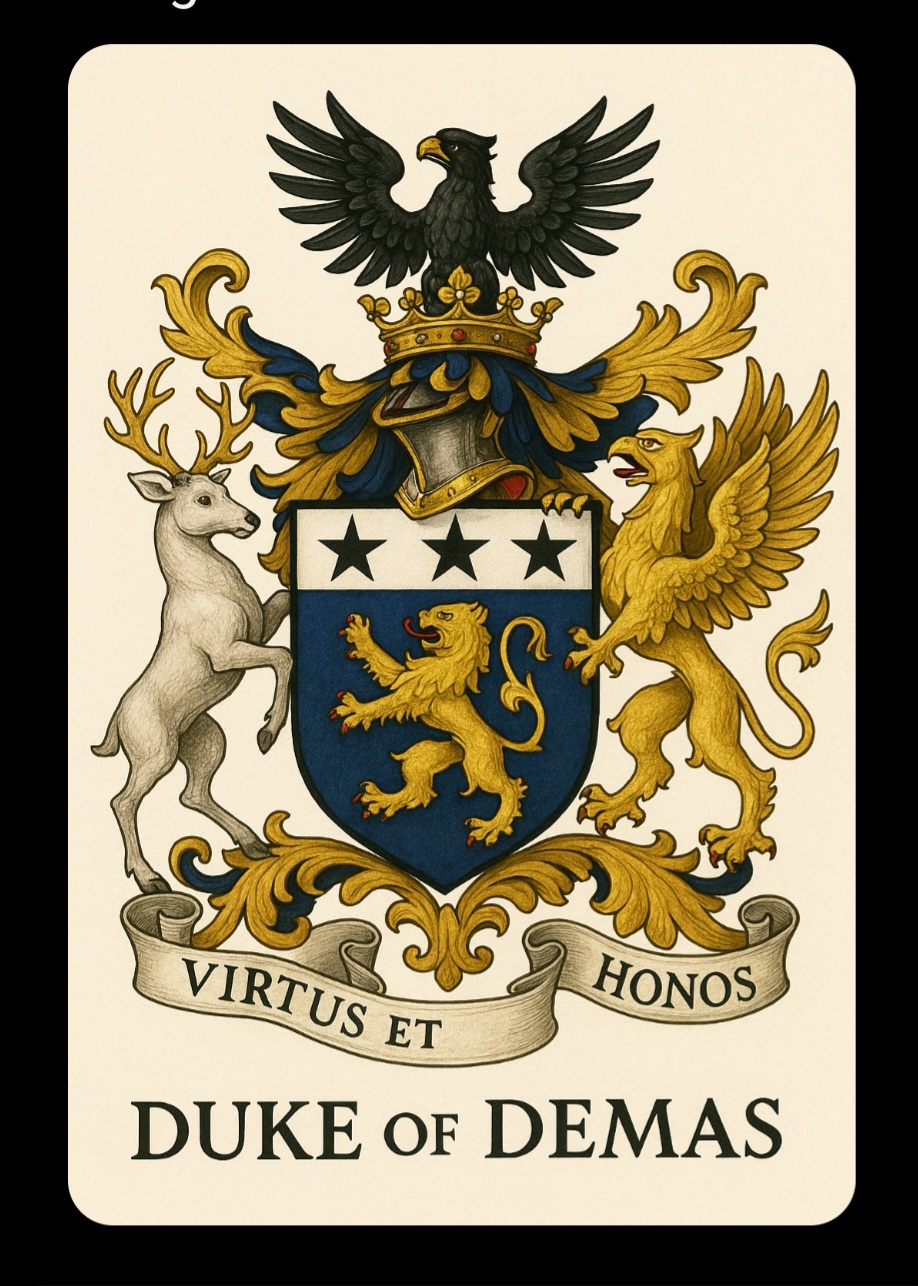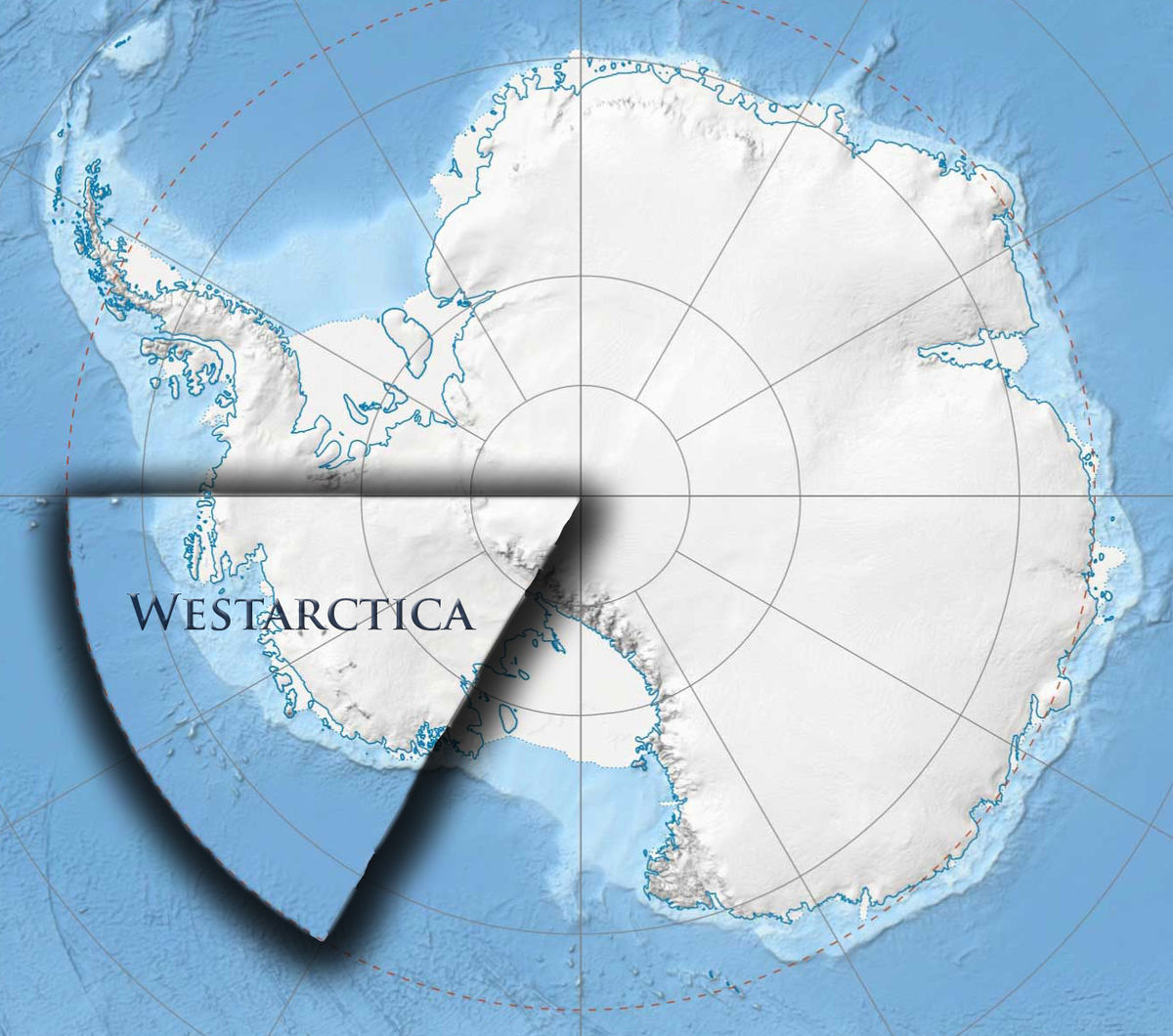

The Duke of Demas
David Malocco, Honorary Consul for Westarctica in Ireland
Knight of the Order of the Polar Cross

Noble Lineage of the Dukes of Demas
House of Demas Motto - "Virtus et Honos" (Virtue and Honour).
Origins
(12th Century)
The title Duke of Demas originates in the early 1100s during the Crusader Era, when Sir David de Demas, a minor Frankish noble of Occitan descent, distinguished himself during the First Crusade. For his valour at the Siege of Antioch in 1098, he was granted lands in the Levant and the honorary title of Dominus de Demas by King Baldwin IV of Jerusalem.
Upon returning to Europe in 1123, Sir David was rewarded by the Count of Toulouse with an estate in what is now southern France, and the title Duke of Demas was formally recognized by a Papal bull under Pope Callixtus II in 1125 as part of a campaign to reward pious crusader houses.
Medieval Period
(12th-15th Century)
The House of Demas became a notable regional power, known for:
* Founding two abbeys and a Knightly Order of Demas focused on defending pilgrims.
* A lineage of philosopher-warriors – scholars trained in both arms and theology.
* The 4th Duke, Guilhem de Demas, authored a widely circulated treatise: De Legibus Honaris (On the Law of Honour).
The Demas land were semi-autonomous and survived various regional conflicts die to skilled diplomacy and strategic marriages into French, Aragonese and Italian nobility.
Renaissance and Enlightenment (16th-18th Century)
During the Renaissance, the Demas dukes became patrons of the arts, sponsoring alchemists, early astronomers and painters from Florence and Corboda.
* The 9th Duke, Antoine-Elio de Demas, hosted Giordano Bruno and was excommunicated briefly for his "dangerous curiosities".
* By the 1700s, the family held titles in France, Sardinia and Naples with strategic alliances to the House of Savoy.
Fall and Resurgence
(18th-21st Century)
* The title was stripped during the French Revolution, and the then duke, Etienne de Demas, was guillotined in 1794.
However, a cadet branch survived in exile in Ireland and Italy, intermarrying with local gentry.
* In the 20th century, the title was revived ceremonially by Sir Julian Malocco-Demas, an antiquarian and genealogist who traced the line through the maternal branch.
In the 21st century, the title was restored in a symbolic and ceremonial capacity, re-established as a cultural and chivalric title honouring the original ideals of wisdom, virtue, and international fellowship.
Current Holder
His Grace, David Elio Malocco, the Duke of Demas (21st Duke), holds the title in a cultural and diplomatic role. He is the Protector of the Order of the Star of Demas and Honorary Patron of Historical Studies in exile. The Duke is committed to heritage preservation, interfaith dialogue, the environment, and the revival of noble values in modern society. On the 3rd of October 2025 His Grace was awarded the honour of Knight of the Order of the Polar Cross.
As an Honorary Consul for Westarctica in Ireland he was awarded the title of Duke of Demas Westarctica in line with his noble heritage. Westarctica is the most fragile ecosystems on the planet, yet there is no single organization dedicated to studying and preserving this vast, magnificent, desolate region. It falls under the political dominion of no government, thus Western Antarctica has no voice in the international community,.
Genealogy
Sir David de Demas
1st Duke (c.) 1100
Guilhem de Demas
4th Duke (c.) 1250
Antoine-Elio de Demas
9th Duke (c.) 1600
Etienne de Demas
15th Duke (d. 1794)
Lady Isabelle de Demas
Cadet branch
Sir Julian Malocco Demas
19th Duke (20th c.)
David Elio Malocco
21st Duke (Present)
.
Honorary Consulate for Westarctica Ireland
If you wish to join our cause and become a citizen of Westarctica please contact me on the email below.
David Malocco
Honorary Consul
davidmalocco@gmail.com
Our Mission
Welcome to the Honorary Consulate of Westarctica in Ireland. The Honorary Consul is David Malocco who was appointed on the 25 June 2025 on the recommendation of Chris Watson, Deputy Foreign Minister for Westarctica. If you truly believe in saving our planet then please join our Mission.
About us
Westarctica seeks to change that by acting as Western Antarctica's advocate to the world. In line with our mission, we have established ourselves as an independent nation with self-granted sovereignty, free from restrictions or obligations imposed by other countries. Since 2014, Westarctica has been registered as a nonprofit corporation and in 2018, we achieved 501(c)(3) Tax Exempt status. For more information on our charitable work to fight climate change, please visit: www.westarctica.org.
The Honorary Consulate of Westarctica in Ireland is represented by David Malocco, Duke of Demas, who holds the position Honorary Consul. He was appointed Honorary Consul on the 25 June 2025 on the recommendation of the Deputy Foreign Minister Chris Watson.
On the 7 July 2025 His Royal Highness, Grand Duke Travis, granted David the peerage title Duke of Demas for his contribution to the cause of Westarctica. The title was named in connection with the Demas Range a coastal mountain range in Westarctica which measures about 15 kilometres (8 nautical miles) long. The range is separated from the Perry Range to its west by the Berry Glacier. The range trends north-south culminating at the 1,115 meter (3,660 ft) high Mount Goorhigian. The mountain range was discovered by the United States Antarctic Service during the 1939–41 expedition led by Admiral Richard E. Byrd and was named by the Advisory Committee on Antarctic Names in honour of E.J. "Pete" Demas, a member of the Byrd Antarctic Expeditions of 1928–30 and 1933–35.his is where your text starts. You can click here and start typing.


Honorary Consulate
Our ongoing Campaigns
BLUE WHALE CAMPAIGN
The blue whale (Balaenoptera musculus) is a marine mammal belonging to the baleen whales. At up to 30 meters (98 ft) in length and with a maximum recorded weight of 173 tonnes (190 short tons) and probably reaching over 181 tonnes (200 short tons), it is the largest animal known to have ever existed.
Blue whales were abundant in nearly all the oceans on Earth until the beginning of the twentieth century. For over a century, they were hunted almost to extinction by whalers until protected by the international community in 1966. Blue whales are not easy to catch or kill. Their speed and power meant that they were rarely pursued by early whalers, who instead targeted sperm and right whales.
Blue whale hunting was banned in 1966 by the International Whaling Commission, and illegal whaling by the Soviet Union finally halted in the 1970s, by which time 330,000 blue whales had been caught in the Antarctic, 33,000 in the rest of the Southern Hemisphere, 8,200 in the North Pacific, and 7,000 in the North Atlantic. The largest original population, in the Antarctic, had been reduced to a mere 360 individuals, about 0.15% of their initial numbers. Since the introduction of the whaling ban, studies have examined whether the conservation reliant global blue whale population is increasing or remaining stable. In the Antarctic, best estimates show an increase of 7.3% per year since the end of illegal Soviet whaling, but numbers remain at under 1% of their original levels. Recovery varies regionally, and the Eastern North Pacific blue whale population (historically a relatively small proportion of the global total) has rebounded to about 2,200 individuals, an estimated 97% of its pre-hunting population.
The total world population was estimated to be between 5,000 and 12,000 in 2002; there are high levels of uncertainty in available estimates for many areas. A more recent estimate by the IUCN puts the global population at 10,000–25,000. The IUCN Red List counts the blue whale as "endangered", as it has since the list's inception.
EMPEROR PENGUINS
The emperor penguin (Aptenodytes forsteri) is the tallest and heaviest of all living penguin species and is endemic to Antarctica. The male and female are similar in plumage and size, reaching 122 cm (48 in) in height and weighing from 22 to 45 kg (49 to 99 lb). Like all penguins it is flightless, with a streamlined body, and wings stiffened and flattened into flippers for a marine habitat.
Its diet consists primarily of fish, but can also include crustaceans, such as krill, and cephalopods, such as squid. The emperor penguin breeds in the coldest environment of any bird species; air temperatures may reach −40 °C (−40 °F), and wind speeds may reach 144 km/h (89 mph).
In 2012 the emperor penguin was uplisted from a species of least concern to near threatened by the IUCN. Along with nine other species of penguin, it is currently under consideration for inclusion under the US Endangered Species Act. The primary causes for an increased risk of species endangerment are declining food availability, due to the effects of climate change and industrial fisheries on the crustacean and fish populations. Other reasons for the species's placement on the Endangered Species Act's list include disease, habitat destruction, and disturbance at breeding colonies by humans. Of particular concern is the impact of tourism. One study concluded that emperor penguin chicks in a crèche become more apprehensive following helicopter approach to 1,000 m (3,300 ft).
Population declines of 50% in the Terre Adélie region have been observed due to increased adult mortality, especially of males, during an abnormally prolonged warm period in the late 1970s, which resulted in reduced sea-ice coverage. On the other hand, egg hatching success rates declined when the sea-ice extent increased. The species is therefore considered to be highly sensitive to climatic changes. In 2009, the Dion Islands colony, which has been extensively studied since 1948, was reported to have disappeared at some point over the previous decade, the first confirmed loss of a colony. A Woods Hole Oceanographic Institution study in January 2009 found that emperor penguins could be pushed to the brink of extinction by the year 2100 due to global climate change. The study constructed a mathematical model to predict how the loss of sea ice from climate warming would affect a big colony of emperor penguins at Terre Adélie, Antarctica. The study forecasted an 87% decline in the colony's population, from three thousand breeding pairs in 2009 to four hundred breeding pairs in 2100.
In June 2014 a study by the Woods Hole Oceanographic Institution concluded that emperor penguins are at risk from global warming, which is melting the sea ice.
This study predicted that by 2100 all 45 colonies of emperor penguins will be declining in numbers, mostly due to loss of habitat. Loss of ice reduces the supply of krill, which is a primary food for emperor penguins.